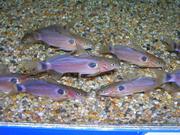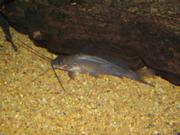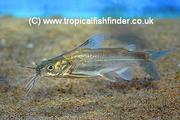Article categories:
Select a category below to view articles on each subject.
Search
Enter your keyword/s below to search :

Fish delivered straight to your door from Wildwoods
Hundreds of Species available today…
TFF Mailing List
Join the TFF mailing list today and we will email you with latest offers, news items and more.
Asian Community Catfish: Mystus spp.
Often overlooked in favour of the South American Corydoras species, the various Mystus species from Southeast Asia have the potential to make charming additions to community tanks. Unlike Corydoras they are active carnivores, but the smaller species hunt for invertebrates rather than fish, and can be kept alongside tetras, barbs and other community fish.
Taxonomy and distribution
Mystus are members of the family Bagridae and distributed across Africa and Asia. Historically the group has been something of a catch-all taxon that contained species now recognised as belong to their own distinct families. Several familiar African catfish, including the Giraffe Catfish (Auchenoglanis occidentalis) and the Ornate Bagrid (Chrysichthys ornatus) once belonged to the Bagridae, but are now placed in their own family, the Claroteidae.
Nonetheless, advanced aquarists will have a fair idea of what the average ‘bagrid’ catfish looks like. Like all catfish they lack scales, but they also lack the armoured scutes along the flanks characteristic of many other catfish species. They have long, streamlined bodies equipped with powerful tail fins, and in many cases the adipose fin is quite well developed, often scarcely smaller than the dorsal fin. The whiskers are long and point forwards, and the mouth opens more or less at the front of the head rather than underneath. All this reveals catfish well equipped for life swimming about in streams and rivers hunting for prey.
Over fifty species of Mystus are currently recognised, but many others used to be included in the genus but have now been placed in other genera, perhaps most notably the ferocious Crystal Eye Catfish Hemibagrus wyckii (formerly Mystus wyckii) and the Asian Red-Tailed Catfish Hemibagrus nemurus (formerly Mystus nemurus).
General care
On the whole these catfish are easy to keep. For a start, they are most adaptable with regard to water chemistry and will do well across the same sort of conditions as most other aquarium fish. Soft water may be preferred in some cases, but others will thrive in hard water, and at least one of the species mentioned here is a brackish water specialist. Most species will do well across a broad temperature range as well.
Feeding doesn’t present any real problems, with Mystus readily consuming all the usual foods such as suitably-sized live and wet-frozen foods, chopped seafood, catfish pellets, and any uneaten flake food they happen to come across. They are nocturnal fish in the wild, but once settled should take food during the day as well, especially in quiet, well-planted tanks with lots of shade.
Social behaviour and compatibility
Many Mystus species are gregarious and need to be kept in groups, but this is not always the case. This aspect of their care must be researched carefully before purchase. When social species are kept singly they tend to be nervous and very shy. Conversely, the more territorial species can be surprisingly aggressive and may not even tolerate other catfish, let alone their own kind.
As community fish Mystus can work well, but they’re all predatory fish and tankmates will need to be of appropriate size. Anything small enough to swallow whole will probably be fair game, and ideally tankmates will be of about equal size to the catfish or larger. Small, narrow-bodied fish like Neons will be particularly at risk.
Two-Spot Bagrid, Mystus bimaculatus
At less than 8 cm in length when fully growth, this is one of the smallest species in the genus and one of the most frequently traded. It is a beautiful fish, pinkish-brown in colour with a large black spot behind the shoulder and a black band around the caudal peduncle. The species is very sociable, and must be kept in a group, preferably consisting of at least five specimens, and the more the better. While this species is quite adaptable and has proven to be fairly tolerant of hard water, it is a blackwater species in the wild, so soft, slightly acidic water is recommended; in community settings, aim for 2-15 degrees dH, pH 6-7.5. Given its small size this species isn’t much of a threat towards its tankmates, but obviously very small fish and shrimps may be at risk if these catfish are hungry. Good tankmates include rasboras, tetras and barbs, as well as things like gouramis and potentially even dwarf cichlids.
Pearl Mystus, Mystus castaneus
This species was for long imported as Mystus armatus, but that appears to be an Indian species distinguished by a thin band running along the length of its body (see below). By contrast this Southeast Asian catfish is largely unmarked except for a dark blotch on the caudal peduncle. As its name suggests it has a metallic, pinkish-brown colouration that shimmers beautifully in subdued lighting. It is sociable and best kept in groups of at least three specimens. While predatory, it only gets to 15 cm in length, and can therefore be kept with all sorts of medium-sized community fish including barbs, gouramis, loaches, swordtails, platies and so on. The species occurs in a variety of stream and riverine habitats in the wild and does not appear to be fussy about water chemistry. Nonetheless, extremes should be avoided.
Mystus mysticetus
This is another commonly traded species with attractive colours. It is pinkish-brown with three off-white stripes running along its flanks and a small black patch just behind the gill cover. It has four pairs of particularly long whiskers and strikingly large eyes, and both these features reveal a catfish well-adapted to hunting at night. Although not a big species, only getting to about 12 cm or so when fully grown, it will readily consume bite-sized fish and shrimps, so tankmates need to be of appropriate size. Deep-bodied barbs and tetras will be fine, as will things like gouramis and most dwarf cichlids. It is one of the gregarious species, and needs to be kept in a group of three or more specimens.
Antenna Bagrid, Mystus armatus
Despite the widespread use of this fish’s scientific name in the hobby literature, this Indian species is only occasionally seen in aquarium shops. In fact most of the so-called ‘Mystus armatus’ in the trade are in fact Mystus castaneus, as has been mentioned above. The Antenna Bagrid is a medium-sized species adapted to fast-water habitats where the water is fairly cool and rich with oxygen. So while it appears to be quite hardy and adaptable, optimal conditions would be those of a hillstream-type aquarium maintained at around 22-25 degrees C and provided with a good strong water current. This species does not move about as much as some of the other members of the genus, and likes a cave or shelter somewhere out of the water current where it can rest between excursions. It is not a gregarious species and may be kept singly. Tankmates should be chosen from those adapted to fast-flowing environments, for example Barilius spp., Giant Danios, some of the loaches, and medium-sized loricariid catfish.
Asian Upside-Down Catfish, Mystus leucophasis
This is one of the bigger species, getting to around 30 cm when fully grown, but a popular species nonetheless and regularly seen in aquarium shops. As its common name suggests, this species is able to invert itself and will regularly swim about upside-down. Colouration is basically dark grey with a few white speckles. While this species can be kept in mixed-species set-ups, it is not a community fish as such. It is predatory of course, but is also quite territorial and won’t tolerate its own kind or any other catfish that tries to share its chosen cave or shelter. Good tankmates include big midwater barbs and characins, as well as suitably robust rather than aggressive South American or African cichlids. Water chemistry is not an issue, and this species can do well in both soft and hard water. A good species for advanced aquarists with large rough-and-tumble community tanks.
Estuarine Bagrid, Mystus gulio
This last species is not commonly traded but well worth mentioning. It is a true brackish water catfish, and as such could be placed alongside such fish as monos, scats and archerfish. Wild specimens can reach a maximum length of over 40 cm, but that is exceptional, and most specimens are less than half that size, 15-20 cm being typical. Colouration is basically unmarked silver, darker above, lighter below. This is a schooling species and should be kept in groups rather than singly, but is otherwise undemanding. Overall an excellent choice for large brackish water communities, though it will of course view very small tankmates as food.
Other fish articles:
Other fish articles you may be interested in are listed below, click an article for full details.
-
FISH ARTICLE
-
FISH ARTICLE
-
FISH ARTICLE
-
FISH ARTICLE









